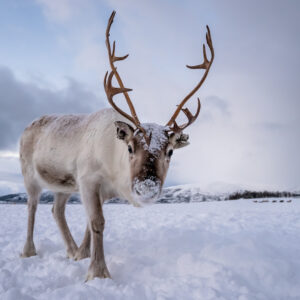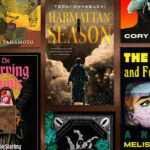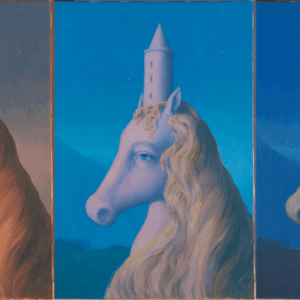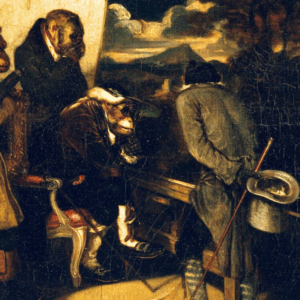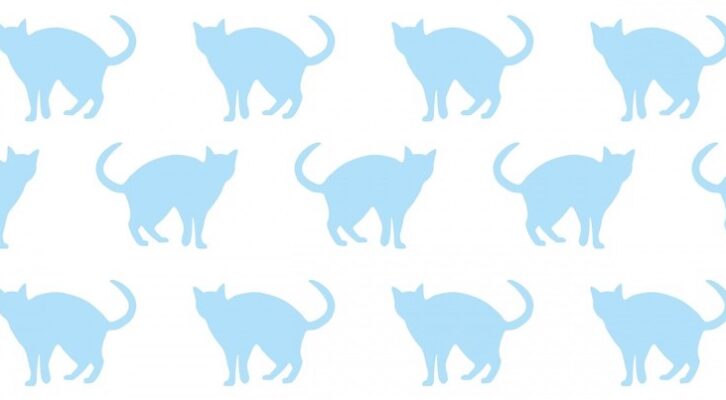
What Our Relationship With Cats Reveals About Ourselves
Rebecca van Laer: “If dogs are our servants, cats are our shadows.”
One fantasy that comes up again and again: I wish cats ruled the world.
When we imagine this alternate reality, all our favorite projections blur together in a vague impression of what might be—a world of softness, purrs, leisure, and play without work or discipline. In short, a world of freedom.
But if cats were truly free—to live, to die, to dominate—what would humans be?
*
We forget that this particular alternate reality is not so implausible. In The Lion in the Living Room, Abigail Tucker reminds that our ancestors were certainly prey for lions and leopards and tigers. As obligate carnivores with ferocious teeth, big cats were both motivated and equipped to rip primates to shreds. And they did. For centuries, we didn’t fight back; we followed instead. Some scientists suggest that humans, in fact, made evolutionary leaps as scavengers subsisting off of cats’ felled prey, picking the bones clean. Having developed a taste for meat, we began to herd and farm and domesticate, reducing the available food for cats. As human civilization developed in Egypt and Rome and India, lion and tiger populations were fragmented, decimated. Tucker suggests that we know this on some primal level: “Maybe a lion purring in our lap or cavorting in our living room evokes our global mastery, our total control of nature.”
I do not think love comes easily to me—love for people, that is. For cats, who have been accused of loving back too little or not at all, it is a different story.
But we do not have total control of Felis catus, the species we domesticated. Cats roam free all over the world, with an impact that we certainly do not want. In 2013, Nature Communications published a study estimating that, in the United States, cats kill somewhere between one and four billion birds each year, and perhaps five times as many small mammals. Its authors, along with many biologists, consider cats an invasive species. It may rankle the cat lover’s heart to hear their pet lumped in with kudzu and the spotted lanternfly, which we are taught to kill on sight. But how else can we classify cat colonies and what they do? There are somewhere between 60 million to 100 million feral cats in the United States, rivaling the number of cozy pets. And indoor/outdoor cats hunt, too, even if their owners don’t know it. Studies suggest they bring just a fraction of their prey home. Birds, chipmunks, snakes, rabbits—cats can and will kill animals up to three times their size. And yet we let our pets roam, contributing to the problem.
Perhaps it is because we don’t want to admit that, if cats are an invasive species, so are we.
*
When I lie in bed asking Steven “What if cats ruled the world?,” I am an individual renouncing this mastery and its results—the shame of it, of what we have created. But the more I try to imagine this alternative, this fantasy, I see that other memoirists have already encountered it, or at least its specter.
Doris Lessing’s On Cats, for example, is a classic of the cat book genre, marketed as tender and sweet. But it opens with two awful scenes of violence, one after the other. The first is a mere error. Growing up in what is now Zimbabwe, Lessing and her family lived with pet cats and wildcats, the line between them often blurring, just as they do today (the two virtually indistinguishable in appearance, with abandoned pets quickly reverting to their wild ways). Lessing writes, “Wild cats brought into dubious question the status of our comfortable beasts….We hated wild cats, which spat and clawed and hissed and hated us.” The house cats themselves are already seen as beasts, and their wild cousins make them seem potentially beastlier. The slipperiness becomes a source of misunderstanding when a cat is caught up a tree. Assuming it is a wild chicken thief, young Doris shoots it herself, only to discover she has killed her former pet, Minnie. Lessing expresses no regret or agony at her childhood actions, or at what happens next. Following this murder, her mother kills the litter of Minnie’s kittens found nearby. In Lessing’s terminology, she “destroys” them, as if they are paper or glass rather than flesh and blood. While this is nasty work, it is still work, a necessary means to a necessary end.
Another task, another job, becomes unavoidable when an explosion of cats and kittens overtakes the property. Although they are all pets—friendly—they have bred too much and too quickly, as cats are apt to do. Lessing’s father enlists her help to round them up into a single room, which he then enters with a World War I-era shotgun, round after round sounding out. (She does not detail the sound of the animal wails that must have accompanied.) As much as she loathes these events, she admits that they barely leave a mark, being mere echoes of a prior loss, that of a little kitten left behind in Tehran when her family moved. “After a certain age—and for some of us that can be very young—there are no new people, beasts, dreams, faces, events: it has all happened before,” she writes.
But this, I think, elides the truth: there is a difference between that single kitten—helpless, hapless, and under her control—and the whole hoard of cats. The loss of a single cat is the loss of a pet; the loss of forty is something else entirely. It is easy to love the individual. But the group, the mass, is a threat.
*
In Cat, Katherine Rogers suggests that coexisting with lawless cats flatters our liberal egos. Cats can be a source of pride, even arrogance: “Most of us would at least like to feel that we do not require unquestioning veneration and obedience from those who share our homes.” Having a cat is, in this account, a form of virtue signaling. I live with a being I cannot control; look at how tolerant I am. But that only applies to a single cat (or two or three), not a growing colony. And as egalitarian or loving as we like to think we are, when we come face-to-face with our own helplessness to fix the problems we’ve created, terror arises. Most of us like to think that we would not do as Lessing’s father did and kill them all. But if one has failed to avoid this situation in the first place, what are the options, really? To care for forty cats, building them a separate home of their own? To make it a prison and keep them from spreading? Or to drive them off somewhere else?
*
Bohumil Hrabal’s memoir, All My Cats, opens on this problem. Hrabal’s wife asks, “What are we going to do with all those cats?” She is concerned about an excessive but potentially manageable number of cats at their country home in Kersko, Czechia: five. How can this little clowder be terrifying when each member is adorable, soft, and warm, curling up with Hrabal between his legs and on his pillow? He tells his wife that there is nothing to worry about. Soon, one will disappear, and then another will wander off. He feigns nonchalance, but whenever in Prague, he is haunted by the threats the cats might face. Some hunters sell their kills for thirty crowns a head. Yet being with the cats is no better, even worse. In his country home, he is tormented by the reality that there are too many, and more coming, as two cats are pregnant.
When they give birth to ten kittens, Hrabal, a cat lover, a man who puts his face against the wet nose of his cat Blackie to comfort himself, realizes what he must do: kill. But soon after bagging six kittens and beating them against the trunk of a tree, their mothers become pregnant again. Full of self-reproach and horror and fear, he looks at his hands stroking the remaining kittens and realizes that “this was just like the photographs from the ghetto, where an SS officer or an execution squad would have their pictures taken standing over a pit filled with corpses.” His digits, his body, his very skin remind him of Nazis, and of American troops posing with the corpses of Vietnamese victims. Yet he finds no solution but to kill again, kill even the cat he loves most. As he looks at Blackie’s corpse, he observes, “One terrible eye was still open…and in that horrifying eye I could see everything I loathed about myself.”
*
There seems no other solution to Hrabal’s problems. Spaying and neutering were not common practice in the United States until the 1970s, much less in 1960s Czechia. But once the population has been reduced, Hrabal is consumed, as one might expect, by guilt. He has only one small moment of respite from it when he is called as a witness in a trial where a neighbor has been accused of killing wild birds. As his testimony goes on, Hrabal admits that he has harbored cats who kill more than the occasional songbird, too. But he has done his part to help, hasn’t he, by killing them? He feels a modicum of relief; perhaps he has done the right thing after all. Perhaps his violence was justified by the other lives he saved, those of the larks and the rabbits.
This hope does not last long. He realizes that he has not just killed animals: “I was guilty…because I had murdered love. That was my sin…I felt guilty and would go on feeling guilty as long as I remained in the world.” (Hrabal died by probable suicide at eighty-two.)
*
I cannot imagine hurting a cat. Their pain is like a claw mark on my heart. When I scroll through Instagram, which feeds me countless stories of cats abandoned, hurt, suffering, I feel burnt up and sick with the evils of humanity, our indifference. My idea that I have rescued, cared for, two creatures fills up something inside of me. Milton and Gus are precious to me because of all they have suffered in the years before I loved them, because of what they suffer now and that I try to remedy—and because of what they might suffer if not for me. I feel virtuous not because of my egalitarianism but because of my love, its strength and purity.
My love for them overlaps with and depends on my love for their kind—and, knowing cats’ collective capacity to decimate, it also snags.
It means all the more because I do not think love comes easily to me—love for people, that is. For cats, who have been accused of loving back too little or not at all, it is a different story. While their love is intermittent, restrained, there is such pleasure in learning to accept its limits, and to revel in the moments when they show it: when Steven and I are in bed with Milton on my lap and Gus licking his head, our whole little family together, although the most attention Gus pays me these days is when he steps on me on his way to greet Steven. Still, I thank him for the pressure of his little paws, and for the mornings when he wakes up on the couch when I go down for coffee and lets out a little chirp to greet me and the day. Milton offers more, more than any cat has ever offered me before: when I am doing Child’s Pose to stretch my back, he comes and sits on my shoulder blades. When I watch TV at night, he gets into my lap, squirming and purring. We develop a new vocabulary: he is a “dynamic petee,” restless as we stroke him, unlike the cats we have had thus far—static petees. When he screams, asking for Greenies or brushies or play, I tell him, “You have it so easy.” But I say this not to discipline or change him; I like that he is a whiner. I like that he knows how to ask for what he wants.
Yet I cannot always give it to him; I do not.
*
We cannot let cats take over the world. We cannot let them have litter after litter of kittens. We cannot let them eat whatever they want. This is for practical reasons: they would kill everything we haven’t already.
I say this tongue-in-cheek, but the prospect feels more and more real to me. I stopped keeping honeybees when I realized their reputation as ecologically necessary is farcical, to say the least. Like cats, they are a non-native species, inhabiting urban and suburban areas at massive and unnatural levels, outcompeting North American pollinators while spreading disease. “Save the honeybee” is just good marketing; they are not the insects we should focus on. And as for the cats? We keep ours inside. We feed them the most responsibly sourced food we can find. But still, my love for them overlaps with and depends on my love for their kind—and, knowing cats’ collective capacity to decimate, it also snags.
*
What are we going to do with all those cats?
Cats, like dogs, have walked a path parallel to ours for centuries. If dogs are our servants, cats are our shadows. On ships, across continents, in cities and in suburbs, trash dumps and nature preserves, they have followed us and our refuse, continuing our work of domination. We have fragmented the natural world; they have hunted in the cracks we create. We took out apex predators; they stepped into their place. We reshaped ecosystems and habitats; they aided. Perhaps they are not so much domesticated by humans as accessory to us—not in the sense of a purse, but of a crime. And despite or because of all the things we lack and project onto them—the capacity for pure love, the freedom to enjoy play and rest and laziness—we want to deny what we share: the capacity, perhaps even the instinct, to destroy.
__________________________________
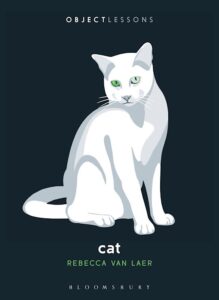
From Cat by Rebecca van Laer. Copyright © 2025. Available from Bloomsbury Academic, an imprint of Bloomsbury Publishing.
Rebecca van Laer
Rebecca van Laer is a writer based in the Hudson Valley. She is the author of a novella, How to Adjust to the Dark, and a memoir, Cat. Her work appears in The New England Review, Joyland, The Florida Review, and elsewhere.









